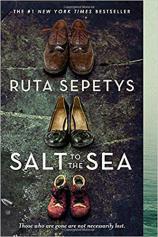Salt to the Sea
Review
Salt to the Sea
SALT TO THE SEA is a jarring, emotional and deeply moving novel by Ruta Sepetys, the author of OUT OF THE EASY and BETWEEN SHADES OF GRAY, that truly lives up to the hype. Told in the alternating perspectives of four young people, SALT TO THE SEA is the story of a little-known maritime disaster that claimed the lives of thousands during World War II. Following the tradition of her previous novels, Ruta Sepetys presents a mixture of fact and fiction that is surprising and incredibly human.
It’s the winter of 1945, and Europe is facing a refugee crisis. Thousands of people have been displaced due to war between Germany and Russia, and the resulting conflict in the rest of the area. For the four protagonists, the Wilhelm Gustloff is their chance at freedom and a new life. All four carry secrets --- some life-changing, some more benign --- but all integral to the novel’s plot. Joana, a Lithuanian nurse, harbors mysterious guilt, while Florian, a Prussian art conservationist, carries an item that could result in his death if discovered. Emilia, a 15-year-old from Poland, carries her secret inside of her, and Alfred, a German sailor on the Gustloff, keeps his fear secret from even himself. Their stories meet and intertwine on journeys that are both personal and universal.
My expectations for this book were incredibly high and yet were somehow exceeded. Sepetys has a gift for handling sensitive subjects with grace and dignity, without glossing over or minimizing their atrocity. I was completely blown away by what I consider her best book yet.
"Sepetys has a gift for handling sensitive subjects with grace and dignity, without glossing over or minimizing their atrocity."
I loved the characters, especially Joana and Florian. I cannot get over how human they were. In a primarily character-driven story, it is understandably important for the characters to be strong and unique. And they were. But I was most intrigued by their individual brokenness, and surprising resilience, especially Emilia’s. The youngest of the protagonists, Emilia, is simultaneously vulnerable and innocent and remarkably strong and worldly. Sepetys manages to strike a balance between these seemingly incompatible characteristics in a way that is subtle and believable.
This prowess extends to almost every character in the work, from lead to supporting. Characters like the shoe poet, the wandering boy, and sorry Eva made the story more realistic than many I’ve encountered. The flawed, generally good leads make for a story that works its way into your heart.
The one character I was not completely satisfied with was Alfred. Told primarily in letters to his sweetheart, Alfred’s point of view seemed dependent and brain-washed. To me, the other characters were much more appealing, and I found Alfred to be a robot to his superiors. Even his backstory and actions throughout the book did nothing to sway me. However, this could be just my opinion. As I found no other flaws in the entire story, I’m inclined to think Alfred is an anomaly.
Although there is very little plot, it is very easy to stay engaged in SALT TO THE SEA. Much time is spent exploring characters’ backstories, so the reader becomes attached to them as they move closer to the inevitable disaster. I legitimately cried at the end of this book. Maybe that’s not much of an endorsement, but to me it’s more important to make people feel than to just tell a story. This is a testament to the impeccable writing of Ruta Sepetys: She connects characters to reality and breaks your heart.
For fans of historical fiction, mild romance, and plot twists that will keep you guessing, Ruta Sepetys’ SALT TO THE SEA is an inspiring and terrifying look into one of the great unknown disasters of World War II and the people who lived through it.
Reviewed by Maggie D. on February 25, 2016
Salt to the Sea
- Publication Date: August 1, 2017
- Genres: Fiction, Historical Fiction, Young Adult 12+
- Paperback: 448 pages
- Publisher: Penguin Books
- ISBN-10: 0142423629
- ISBN-13: 9780142423622





